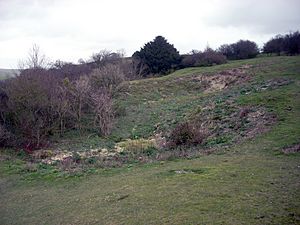Cissbury Ring facts for kids
| Site of Special Scientific Interest | |

Rampart of Cissbury Ring
|
|
| Area of Search | West Sussex |
|---|---|
| Interest | Biological |
| Area | 84.2 hectares (208 acres) |
| Notification | 1986 |
| Location map | Magic Map |
Cissbury Ring is a very old and important place in West Sussex, near Worthing. It is a huge hill fort and also has ancient flint mines. This special site is owned by the National Trust. It's protected as a Scheduled monument because of its history.
Cissbury Ring is the biggest hill fort in Sussex. It's also the second largest in England. It covers about 24 hectares, which is like 60 football fields! People built the strong walls and ditches around 250 BC, during the Middle Iron Age. The fort was used for a while, but then people stopped living there between 50 BC and 50 AD.
This area also has one of the first flint mines in Britain. People dug over 200 shafts here long ago. These shafts were up to 12 metres deep. They also dug tunnels connecting the shafts underground.
Contents
What is Cissbury Ring Like?
The hill fort has big ditches and banks. These were once strong defensive walls. The inner wall goes for over a mile! The ditches were about three metres deep. They were filled with loose chalk and had wooden fences on top.
The hill is about 184 metres high. It's open for everyone to visit. From the top, you can see amazing views. To the west, you might spot Selsey and the Isle of Wight. To the east, you can see Brighton and Beachy Head. Cissbury Ring is the highest point in the area of Worthing.
A Look at History
People have lived around Cissbury Ring for a very long time. Some ancient burial mounds from the Bronze Age have been found nearby. Later, during the Romano-British period, farmers lived inside the fort's walls.
In 1867, a person named Augustus Lane-Fox studied parts of Cissbury Ring. He dug up some interesting things.
During World War II, Cissbury Ring was used by soldiers. The 2nd Argyll and Sutherland Highlanders camped here. They were getting ready for the Normandy landings. At this time, much of the fort was ploughed for growing food. Tanks also accidentally destroyed a pond. A gap was made in the walls for a large gun. This gun was used to fire at ships in the English Channel. An anti-aircraft gun was also placed there.
You can see old items from Cissbury Ring in museums. Some are at Worthing Museum and Art Gallery. Others are in Lewes and the Ashmoleian Museum in Oxford. Even some old silver coins from King Ethelred II (978-1016) are at the British Museum.
Why is it Called Cissbury?
The name Cissbury used to be thought of as "Caesar's fort" or "Cissa's fort." Cissa was a son of an old South Saxon king. But these ideas are probably not true.
Around the year 1000, Cissbury was called 'Sith(m)esteburh'. This name means 'the last fort'. It might mean it was the last fort to be made strong again. Perhaps after another nearby fort, like the one at Burpham. It seems the name Cissbury was changed later. This was to fit the story that it was linked to Cissa.
Ancient Flint Mines
Long before the hill became a fort, people were digging for flint here. Some shafts went down as deep as 12 metres (40 feet). The miners used tools like antler picks. They dug out flint, which was very important. Flint was used to make stone axes. These axes helped them cut down trees and work with wood. This was during the Neolithic period, also known as the New Stone Age.
Cissbury was one of the first flint mines in Britain. It was used for a long time. Other flint mines in Sussex followed a rich layer of flint in the chalk. Examples include Grime's Graves in Norfolk. Harrow Hill nearby is another example.
Cissbury was a very important mining area in the UK. It was used throughout the Neolithic period. It might have been used a little in the Bronze Age and Iron Age too. Most of the tools made here were axes and blades. Flint from Cissbury has even been found as far away as Italy! The axes were made here and then traded. They were essential for clearing forests for farming.
About 200 shafts were dug over 900 years. Each shaft was up to 12 metres deep. They were about 7 metres wide at the top. Up to eight tunnels stretched out from the bottom of these shafts. These tunnels often connected to each other.
In the 1950s, John Pull dug into some mine shafts. He found the remains of a young woman. She might have been killed in a tunnel collapse around 2000 BC. He also found charcoal, possibly from her torch. A tiny whale carved from chalk was with her. Some people think the shaft might have been used for a special burial. Remains of two other people were also found in different shafts. This suggests that the old mines might have been used for burials. Or, perhaps smaller people, like women or young people, were sent into the narrow tunnels to get flint.
This site is important because it shows a big change. Before, people just dug flint from the surface. But at Cissbury, they started deep shaft mining. This took more effort but gave them better quality flint.
Wildlife and Nature
Cissbury Ring is a special place for nature. It has chalk grassland, scrub, and neutral grassland. You can find plants like Upright brome here. Common grasses include Yorkshire fog and sheep's fescue. The scrub areas are important homes for birds and butterflies.
Images for kids



